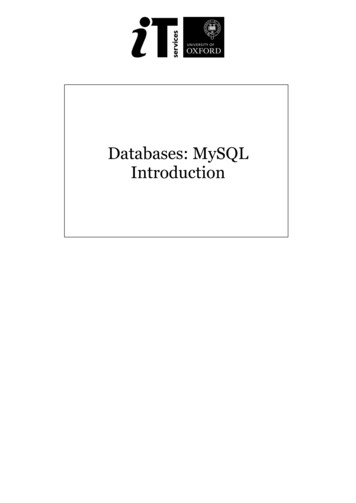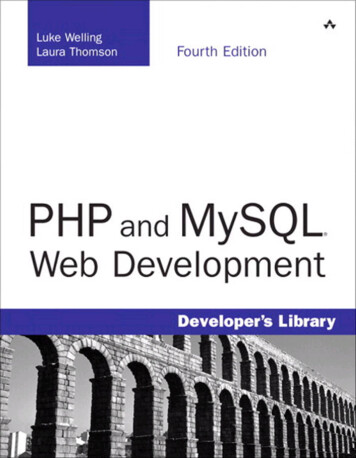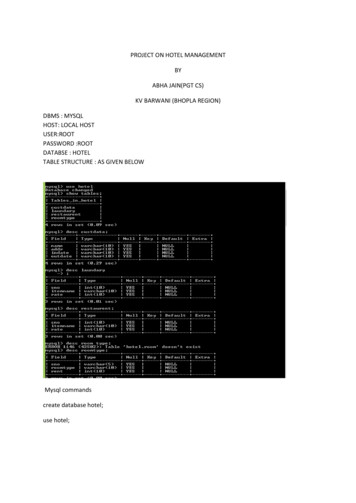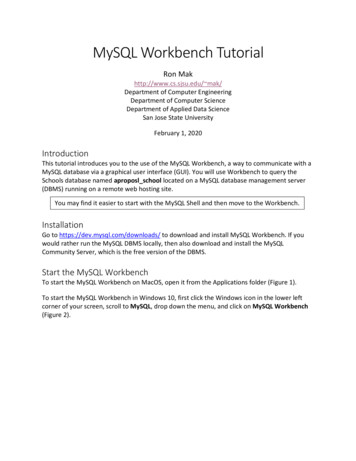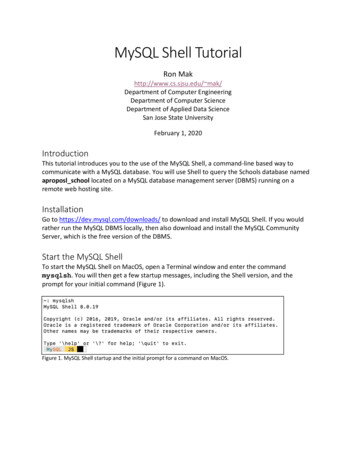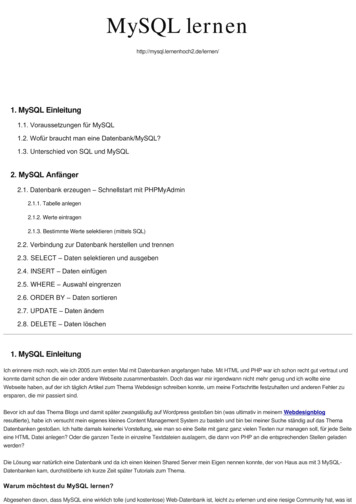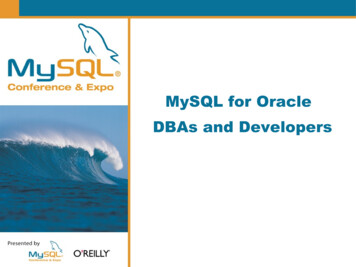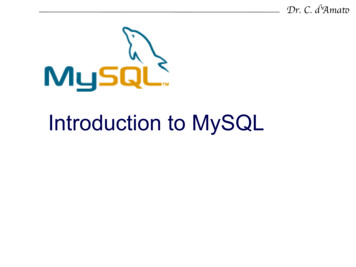
Transcription
Dr. C. d'AmatIntroduction to MySQL
Dr. C. d'AmatAcknowledgeThese slides are a modified version of theslides available online at https://www.google.it/url?sa t&rct j&q &esrc s&source web&cd 1&c on-to-mysql/4
Dr. C. d'AmatRoad Map Introduction to MySQLConnecting and DisconnectingEntering Basic QueriesCreating and Using a Database3
Dr. C. d'AmatAttribution Most of these slides are based directlyon the MySQL Documentation. Most information comes from Chapter 3,MySQL torial.html /manual Tuto4
Dr. C. d'AmatIntroduction to Mysql5
MySQL Dr. C. d'AmatMySQL is a very popular, open source DBMSMySQL databases are relationalOfficially pronounced “my Ess Que Ell” (not my sequel).Handles very large databases;very fast performance; reliable.MySQL is compatible with standard SQLWhy are we using MySQL? Free (much cheaper than Oracle!)Each student can install MySQL locally.Multi-user access to a number of databases offeredEasy to use Shell for creating tables, querying tables, etc.Easy to use with Java JDBCMySQL is frequently used by PHP and Perl Commercial version of MySQL is also provided (including technical6support)
Dr. C. d'AmatHistory of MySQL Founded and developed by David Axmark, AllanLarsson, and Michael “Monty” Widenius Named after Monty's daughter,daughter My MySQL Dolphin logo is “Sakila”,Sakila the name of atown in Arusha, Tanzania Written in C and C Works on many different platforms Sun acquired MySQL AB in Jan 2008 for 1billion dollars
Dr. C. d'AmatMySQL Products Overview
Dr. C. d'AmatMySQL: characteristicsMySQL Server works in: client/server systems a system that consistsof a multi-threaded SQL server that supportsdifferent backends, several different clientprograms and libraries, administrative tools,and a wide range of application programminginterfaces (APIs). embedded systems provide MySQL Serveras an embedded multi-threaded library that canbe linked into an application to get a smaller,faster, easier-to-manage standalone product.
Dr. C. d'AmatMySQL: Features & Benefits
Dr. C. d'AmatMySQL: Features & Benefits
Dr. C. d'AmatMySQL: Architecture
Dr. C. d'AmatMySQL: Community & Customers
Dr. C. d'AmatMySQL: WorkbenchMySQL Workbench enables: a DBA, developer, or data architect to visually design, generate, and manageall types of databases including Web, OLTP, and data warehousedatabases It includes everything a data modeler needs forcreating complex ER models, and also deliverskey features for performing difficult changemanagement and documentation tasks thatare normally time consuming
Dr. C. d'AmatMySQL: WorkbenchSome characteristics Forward and Reverse Engineering A visual data model can easily be transformedinto a physical database on a target MySQLServer with just a few mouse clicks. it can also import SQL scripts to build modelsand export models to DDL scripts that can berun at a later time. Change Management
Dr. C. d'AmatMySQL Workbench Database Documentation– Documenting database designs can be a timeconsuming process. MySQL Workbenchincludes DBDoc that enables a DBA ordeveloper to deliver point-and-click databasedocumentation.– Models can be documented in either HTML orplain text format, and includes all the objectsand models in a current MySQL Workbenchsession
Dr. C. d'AmatResources General starting point http://www.mysql.com/ Developer focused http://dev.mysql.com/
Dr. C. d'AmatInstalling MySQL
MySQL: InstallationDr. C. d'AmatInstruction available at Ch. 2 of theMySQL tutorial available html
Dr. C. d'AmatConnecting and Disconnettingto/from MySQL
ConventionsDr. C. d'Amat commands meant to be executed fromwithin a particular,for example, shell root-shell is similar but should beexecuted as root mysql indicates a statement that hasto be executed from the mysql clientprogram SQL keywords are not case sensitive
Dr. C. d'AmatConnecting to MySQL MySQL provides an interactive shell forcreating tables, inserting data, etc. On Windows, just go to c:\mysql\bin,and type: Mysql or mysql -u user -p; Or, click on the Windows icon22
Dr. C. d'AmatSample Session For example:Enter password: *****Welcome to the MySQL monitor. Commands end with ; or \g.Your MySQL connection id is 241 to server version: 3.23.49Type 'help;' or '\h' for help. Type '\c' to clear the buffer.mysql To exit the MySQL Shell, just type QUIT or EXIT:mysql QUITmysql exit23
Dr. C. d'AmatConnecting to MySQLHow to use the mysql client mysql is an interactive program thatenables you to: connect to a MySQL server, Run queries, view the results mysql may also be used in batch mode: place your queries in a file beforehand, then tellmysql to execute the contents of the file To see a list of options provided by mysql shell mysql --help24
Dr. C. d'AmatEntering & Editing commands Prompt mysql issue a commandMysql sends it to the server for executiondisplays the resultsprints another mysql a command could span multiple lines A command normally consists of SQLstatement followed by a semicolon
Dr. C. d'AmatMySQL commands help \hQuit/exit \qCancel the command \cChange database use etc
Dr. C. d'AmatBasic Queries Once logged in, you can try some simple queries. For example:mysql SELECT VERSION(), CURRENT DATE; ----------- -------------- VERSION() CURRENT DATE ----------- -------------- 3.23.49 2002-05-26 ----------- -------------- 1 row in set (0.00 sec) Note that most MySQL commands end with a semicolon (;) MySQL returns the total number of rows found, and the totaltime to execute the query.27
Dr. C. d'AmatBasic Queries Keywords may be entered in any lettercase. The following queries are equivalent:mysql SELECT VERSION(), CURRENT DATE;mysql select version(), current date;mysql SeLeCt vErSiOn(), current DATE;28
Dr. C. d'AmatBasic Queries Here's another query. It demonstrates thatyou can use mysql as a simple calculator:mysql SELECT SIN(PI()/4), (4 1)*5; ------------- --------- SIN(PI()/4) (4 1)*5 ------------- --------- 0.707107 25 ------------- --------- 29
Dr. C. d'AmatBasic Queries You can also enter multiple statements on a singleline. Just end each one with a semicolon:mysql SELECT VERSION(); SELECT NOW(); -------------- VERSION() -------------- 3.22.20a-log -------------- --------------------- NOW() --------------------- 2004 00:15:33 --------------------- 30
Dr. C. d'AmatMulti-Line Commands mysql determines where your statement endsby looking for the terminating semicolon, notby looking for the end of the input line. Here's a simple multiple-line statement:mysql SELECT- USER()- ,- CURRENT DATE; -------------------- -------------- USER() CURRENT DATE -------------------- -------------- joesmith@localhost 1999-03-18 -------------------- -------------- 31
Dr. C. d'AmatCommand promptpromptmeaningmysql Ready for new command.- Waiting for next line of multiple-line command.‘ Waiting for next line, waiting for completion of astring that began with a single quote (“'”).“ Waiting for next line, waiting for completion of astring that began with a double quote (“"”). Waiting for next line, waiting for completion of anidentifier that began with a backtick (“ ”)./* Waiting for next line, waiting for completion of acomment that began with /*.
Dr. C. d'AmatCanceling a Command If you decide you don't want to executea command that you are in the processof entering, cancel it by typing \cmysql SELECT- USER()- \cmysql 33
Dr. C. d'AmatCreating, Removing and GettingInformation for a Database
Dr. C. d'AmatInfo about databases and tables Listing the databases on the MySQL server host mysql show databases; Access/change database mysql Use [database name] Showing the current selected database mysql select database(); Showing tables in the current database mysql show tables; Showing the structure of a table mysql describe [table name];
Dr. C. d'AmatUsing a Database To get started on your own database, first checkwhich databases currently exist. Use the SHOW statement to find out whichdatabases currently exist on the server (and for whichthe user has privileges):mysql show databases; ---------- Database ---------- mysql test ---------- 2 rows in set (0.01 sec)36
Using a DatabaseDr. C. d'AmatView Users (Before MySQL 5.7.6) mysql SELECT User, Host, PasswordFROM mysql.user;Changing password for a user After 5.7.6, use SET PASSWORD mysql ALTER USER user IDENTIFIED BY'new password'; Ex.: ALTER USER 'root'@'localhost'IDENTIFIED BY 'new password'; Before 5.7.6, use SET PASSWORD: mysql SET PASSWORD FOR user 37PASSWORD('new password');
Dr. C. d'AmatUsing a DatabasesCreate a user mysql CREATE USER user[IDENTIFIED BY 'new-password']; See “help CREATE USER”Remove a user mysql DROP USER user;38
Dr. C. d'AmatUsing a Database To create a new database, issue the“create database” command: mysql create database webdb; Note: Database names are case sensitive To the select a database, issue the“use” command: mysql use webdb; To see what database is selected mysql select database();39
Dr. C. d'AmatCreating a Table Once you have selected a database,you can view all database tables:mysql show tables;Empty set (0.02 sec) An empty set indicates that I have notcreated any tables yet.40
Dr. C. d'AmatCreating a Table Let’s create a table for storing pets. Table: pets name: owner: species: sex: birth: ATEVARCHAR isusually usedto store stringdata.41
Dr. C. d'AmatCreating a Table To create a table, use the CREATE TABLEcommand:mysql CREATE TABLE pet (- name VARCHAR(20),- owner VARCHAR(20),- species VARCHAR(20),- sex CHAR(1),- birth DATE, death DATE);Query OK, 0 rows affected (0.04 sec)42
Dr. C. d'AmatShowing Tables To verify that the table has been created:mysql show tables; ------------------ Tables in test ------------------ pet ------------------ 1 row in set (0.01 sec)43
Dr. C. d'AmatDescribing Tables To view a table structure, use the DESCRIBEcommand:mysql describe pet; --------- ------------- ------ ----- --------- ------- Field Type Null Key Default Extra --------- ------------- ------ ----- --------- ------- name varchar(20) YES NULL owner varchar(20) YES NULL species varchar(20) YES NULL sex char(1) YES NULL birth date YES NULL death date YES NULL --------- ------------- ------ ----- --------- ------- 6 rows in set (0.02 sec)44
Dr. C. d'AmatDeleting a Table To delete an entire table, use the DROPTABLE command:mysql drop table pet;Query OK, 0 rows affected (0.02 sec)45
Dr. C. d'AmatLoading Data Use the INSERT statement to enter data intoa table. For example:INSERT INTO pet 0',NULL); The next slide shows a full set of sampledata.46
Dr. C. d'AmatMore data nameownerspeciessex 7-12-09m1996-04-2947
Dr. C. d'AmatLoading Sample Data You could create a text file pet.txt'containing one record per line. Values must be separated by tabs, andgiven in the order in which the columnswere listed in the CREATE TABLEstatement. Then load the data via the LOAD DATACommand.48
Dr. C. d'AmatSample Data FileFluffy HaroldClaws GwenBuffy HaroldFang BennyBowser DianeChirpy GwenWhistlerGwenSlim 111997-12-091996-04-29\N\N\N\N1995-07-29\N\N\NTo Load pet.txt:mysql LOAD DATA LOCAL INFILE "pet.txt" INTO TABLE pet;49
Dr. C. d'AmatFor each of the examples,assume the following set of data.nameownerspeciessex 7-12-09m1996-04-2950
Dr. C. d'AmatManipulating Instances ofTables of a Database
Dr. C. d'AmatManipulating Table Instances Remove records of a table– mysql DELETE FROM tableName;– [WHERE where condition]; Update records of a table– UPDATE pet SET birth '198908-31' WHERE name 'Bowser';52
Dr. C. d'AmatQuerying Tablesof a Database
Dr. C. d'AmatSQL Select The SELECT statement is used to pullinformation from a table. The general format is:SELECT what to selectFROM which tableWHERE conditions to satisfy54
Dr. C. d'AmatSelecting All Data The simplest form of SELECT retrieves everythingfrom a tablemysql select * from pet; ---------- -------- --------- ------ ------------ ------------ name owner species sex birth death ---------- -------- --------- ------ ------------ ------------ Fluffy Harold cat f 1999-02-04 NULL Claws Gwen cat f 1994-03-17 NULL Buffy Harold dog f 1989-05-13 NULL Fang Benny dog m 1999-08-27 NULL Bowser Diane dog m 1998-08-31 1995-07-29 Chirpy Gwen bird f 1998-09-11 NULL Whistler Gwen bird 1997-12-09 NULL Slim Benny snake m 1996-04-29 NULL ---------- -------- --------- ------ ------------ ------------ 8 rows in set (0.00 sec)55
Dr. C. d'AmatSelecting Particular Rows You can select only particular rows from yourtable. For example, if you want to verify the changethat you made to Bowser's birth date, selectBowser's record like this:mysql SELECT * FROM pet WHERE name "Bowser"; -------- ------- --------- ------ ------------ ------------ name owner species sex birth death -------- ------- --------- ------ ------------ ------------ Bowser Diane dog m 1998-08-31 1995-07-29 -------- ------- --------- ------ ------------ ------------ 1 row in set (0.00 sec)Try the same select: without the last (“) without the last (“) and (;) Try with \c56
Dr. C. d'AmatSelecting Particular Rows To find all animals born after 1998SELECT * FROM pet WHERE birth "1998-1-1"; To find all female dogs, use a logical ANDSELECT * FROM pet WHERE species "dog" AND sex "f"; To find all snakes or birds, use a logical ORSELECT * FROM pet WHERE species "snake" OR species "bird";AND has higher precedence than OR Use paranthesis ifnecessary57
Dr. C. d'AmatSelecting Particular Columns For having only a selection of columnsof a table, just name the columns youare interested, separated by commas. Example: you want to know when yourpets were born– select the name and birth columns. (see example next slide.)58
Dr. C. d'AmatSelecting Particular Columnsmysql select name, birth from pet; ---------- ------------ name birth ---------- ------------ Fluffy 1999-02-04 Claws 1994-03-17 Buffy 1989-05-13 Fang 1999-08-27 Bowser 1998-08-31 Chirpy 1998-09-11 Whistler 1997-12-09 Slim 1996-04-29 ---------- ------------ 8 rows in set (0.01 sec)59
Dr. C. d'AmatSorting Data To sort a result, use an ORDER BY clause. Example: view animal birthdays, sorted by date:mysql SELECT name, birth FROM pet ORDER BY birth; ---------- ------------ name birth ---------- ------------ Buffy 1989-05-13 Claws 1994-03-17 Slim 1996-04-29 Whistler 1997-12-09 Bowser 1998-08-31 Chirpy 1998-09-11 Fluffy 1999-02-04 Fang 1999-08-27 ---------- ------------ 8 rows in set (0.02 sec)60
Dr. C. d'AmatSorting Data To sort in reverse order, add the DESC(descending keyword)mysql SELECT name, birth FROM pet ORDER BY birth DESC; ---------- ------------ name birth ---------- ------------ Fang 1999-08-27 Fluffy 1999-02-04 Chirpy 1998-09-11 Bowser 1998-08-31 Whistler 1997-12-09 Slim 1996-04-29 Claws 1994-03-17 Buffy 1989-05-13 ---------- ------------ 8 rows in set (0.02 sec)61
Dr. C. d'AmatSorting Data Sorting on multiple columns in differentdirections– Get name, species, birth with animals inascending order and date (withinanimal type) in descending order(youngest first)– mysql SELECT name, species, birth FROMpet ORDER BY species, birth DESC;– Try the opposite62
Dr. C. d'AmatSelecting Particular Rows Find out who owns petsSELECT owner FROM pet; Find out who owns pets (without duplicate)SELECT DISTINCT owner FROM pet; Get birth dates for male dogs and female catsSELECT name, species, birth FROM pet WHERE (species "dog"AND sex ”m”) OR (species "cat" AND sex ”f”);63
Dr. C. d'AmatWorking with NULLs NULL means missing value or unknownvalue. To test for NULL, you cannot use thearithmetic comparison operators, suchas , or . Rather, you must use the IS NULL andIS NOT NULL operators instead.64
Dr. C. d'AmatWorking with NULLs Find all your dead petsmysql select name from pet where death IS NOT NULL; -------- name -------- Bowser -------- 1 row in set (0.01 sec)65
Dr. C. d'AmatWorking with NULLs Two NULL values are regarded asequal in a GROUP BY– Ex.: create a query with a group by onan attribute haing NULL values NULL values are presented:first with ORDER BY ASC last with ORDER BY . DESC 66
Dr. C. d'AmatPattern Matching MySQL provides: standard SQL pattern matching regular expression pattern matching SQL Pattern matching: To perform pattern matching, use the LIKE or NOT LIKEcomparison operators By default, patterns are case insensitive Special Characters: Used to match any single character. % Used to match an arbitrary number of characters.67
Dr. C. d'AmatPattern Matching Example To find names beginning with ‘b’:mysql SELECT * FROM pet WHERE name LIKE "b%"; -------- -------- --------- ------ ------------ ------------ name owner species sex birth death -------- -------- --------- ------ ------------ ------------ Buffy Harold dog f 1989-05-13 NULL Bowser Diane dog m 1989-08-31 1995-07-29 -------- -------- --------- ------ ------------ ------------ 68
Dr. C. d'AmatPattern Matching Example Find names ending with fy':mysql SELECT * FROM pet WHERE name LIKE "%fy"; -------- -------- --------- ------ ------------ ------- name owner species sex birth death -------- -------- --------- ------ ------------ ------- Fluffy Harold cat f 1993-02-04 NULL Buffy Harold dog f 1989-05-13 NULL -------- -------- --------- ------ ------------ ------- 69
Dr. C. d'AmatPattern Matching Example Find names containing a ‘w’:mysql SELECT * FROM pet WHERE name LIKE "%w%"; ---------- ------- --------- ------ ------------ ------------ name owner species sex birth death ---------- ------- --------- ------ ------------ ------------ Claws Gwen cat m 1994-03-17 NULL Bowser Diane dog m 1989-08-31 1995-07-29 Whistler Gwen bird NULL 1997-12-09 NULL ---------- ------- --------- ------ ------------ ------------ 70
Dr. C. d'AmatPattern Matching Example Find names containing exactly five characters– use the pattern character:mysql SELECT * FROM pet WHERE name LIKE " "; ------- -------- --------- ------ ------------ ------- name owner species sex birth death ------- -------- --------- ------ ------------ ------- Claws Gwen cat m 1994-03-17 NULL Buffy Harold dog f 1989-05-13 NULL ------- -------- --------- ------ ------------ ------- 71
Dr. C. d'AmatRegular Expression Matching The other type of pattern matchingprovided by MySQL uses extendedregular expressions. Testing for a match for this type ofpattern, use the REGEXP and NOT
Dr. C. d'Amat MySQL: Workbench MySQL Workbench enables: a DBA, developer, or data architect to visually design, generate, and manage all types of databasesFile Size: 763KB

